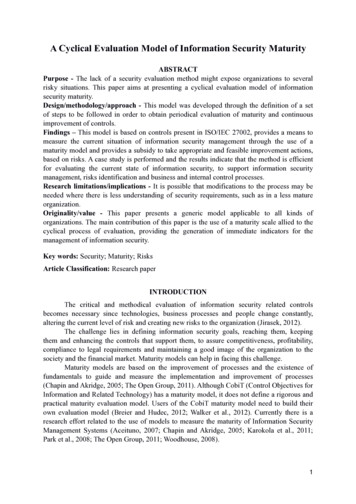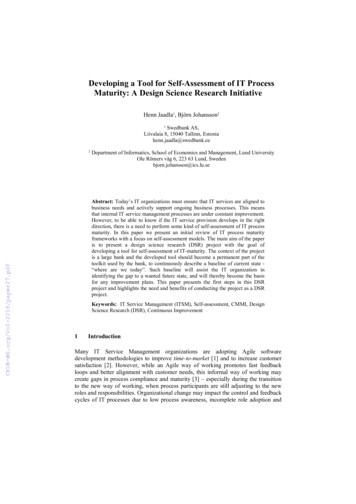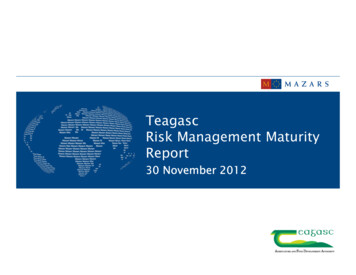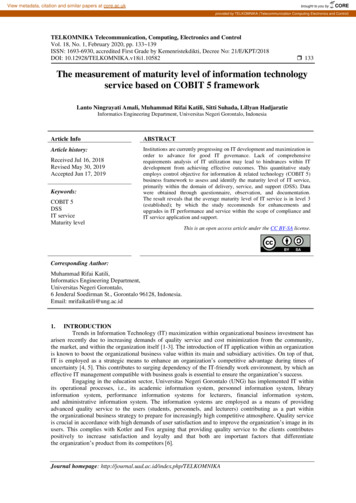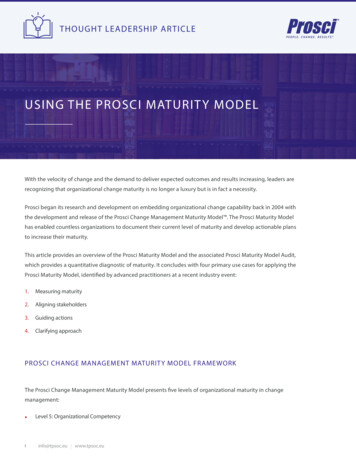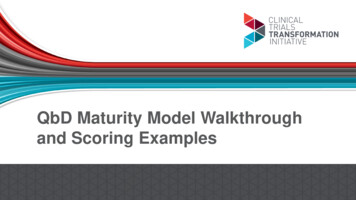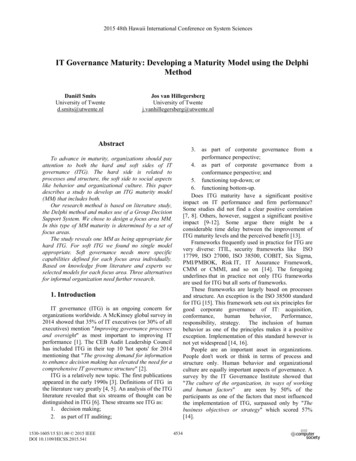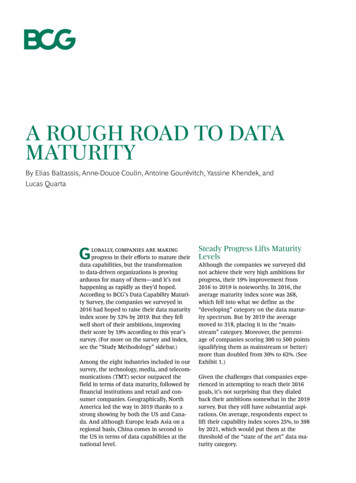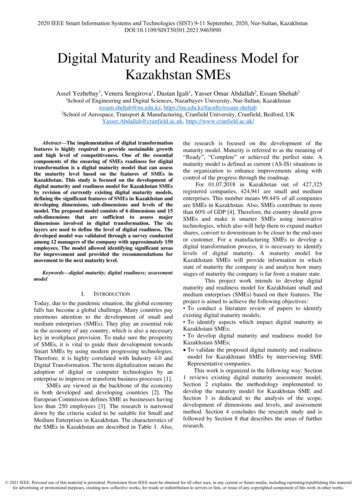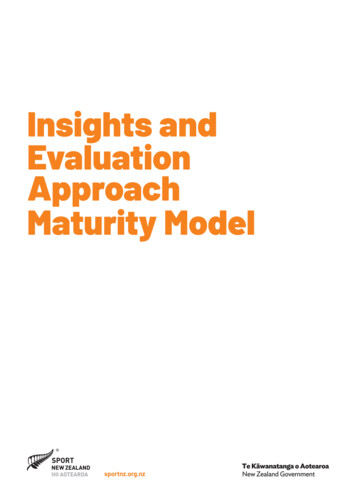
Transcription
Insights andEvaluationApproachMaturity Modelsportnz.org.nz
Insights ApproachThe Insights Approach is one of the Three Approaches promoted by Sport New Zealand. It involves using multiplesources of information to enhance practice through making evidence-based decisions and demonstrating impact.Effective use of evidence increases an organisation’s positive impact and helps us to: make better decisions through learning (positive and negative) be better equipped to influence complex issues improve our day-to-day practice, be more efficient, and maximise resources be more accountable to our work and stakeholders.Insights and Evaluation Maturity ModelSport NZ has prepared a maturity model for each of the Three Approaches. The Insights and Evaluation MaturityModel is a self-assessment tool that aims to support organisations to understand insights and evaluation maturityacross their organisation. Using the model can help you to identify where you might focus your time to furtherembed this approach and enable continuous improvement.How to use the Insights and Evaluation Approach Maturity ModelThe process of conducting an assessment should be completed at an organisational level and span across many orall teams in order to accurately reflect the entire organiation’s level of maturity.The value of the model is in the conversation within your organisation to determine where you are at currently, and,more importantly what should happen next to further embed the Insights Approach.To complete the maturity model, the individual leading the process should: Consult with all relevant staff (e.g. individual and team reflections). Facilitate a discussion on the current practice within your organisation to reach a consensus on the current level ofmaturity under each theme. This should include considering examples of work that might demonstrate the level youare currently operating at. The examples and questions can help to guide these discussions. Record the lower level of maturity if there is a disagreement and if only one part of the level is reached. Identify priority areas and actions to support progression to the next level of maturity. Complete the tool across the organisation annually to inform future activity.Content of the maturity modelThe model is broken into four sections relating to key themes that are essential for achieving continuousimprovement and embedding good practice: Competency (of the organisation) in intelligence - research, evaluation and insights. Intelligence climate provided by leadership. Communication with internal, local, regional and national stakeholders. Systems to support use of evidence.Note: These themes are outcomes on the Sport NZ insights and evaluation investment logic.Each theme is broken down into four domains: knowledge, attitudes, behaviours and process, tohelp understand the components of success within each domain.Each domain is then described at four levels of maturity: emerging, developing, consolidating and highly developed,to help you explore where your organisation might currently be operating.INSIGHTS AND EVALUATION APPROACH MATURITY MODELSPORT NEW ZEALAND2
Embedding an Insights and Evaluation ApproachCompetency (of the organisation) inintelligence - research, evaluation and insightsLEVEL OF MATURITYEmerging - 1Developing - 2Consolidating - 3Highly developed - 4We have basic knowledge ofhow to define our informationneeds and optimise ourinformation sources to betterunderstand a problem enablingus to act.We have good knowledge ofhow to define our informationneeds and optimise ourinformation sources to betterunderstand a problem enablingus to act.We have excellent knowledgeof how to define ourinformation needs and optimiseour information sources tobetter understand a problemenabling us to act.We believe that it is importantto continuously use evidence toreview and adapt many of ourprogrammes and projects.We believe that it is importantto continuously use evidence toreview and adapt most of ourprogrammes and projects.We believe that it is importantto continuously use evidence toreview and adapt almost all ourprogrammes and projects.We actively work with evidenceto address a narrow rangeof issues as they arise andoccasionally critically reflecton our practice.We actively work with evidenceto address a diverse range ofissues as they arise and oftencritically reflect on our practice.We actively work with evidenceto address a very diverse rangeof issues as they arise andalways critically reflect on ourpractice.We have rudimentaryprocedures and tools that aresometimes applied to reflecton and track the change toknow what is working, how well,for whom, and why.We have establishedprocedures and tools that areoften applied to reflect on andtrack the change to know whatis working, how well, for whom,and why.We have advanced proceduresand tools that are alwaysapplied to reflect on and trackthe change to know what isworking, how well, for whom,and why.KnowledgeWe have limited knowledge ofhow to define our informationneeds and optimise ourinformation sources to betterunderstand a problem enablingus to act.AttitudesWe believe that it is importantto continuously use evidence toreview and adapt some of ourprogrammes and projects.BehaviourWe actively work with evidenceto address a very narrow rangeof issues as they arise andrarely critically reflect on ourpractice.ProcessesWe have started thinking aboutprocedures and tools to reflecton and track the change toknow what is/is not working forwhom and why.INSIGHTS AND EVALUATION APPROACH MATURITY MODELSPORT NEW ZEALAND3
What this might look like in practiceKnowledgeStaff know how to define clear research questions, objectives and outcomes for initiatives (e.g. how to create a programme logic model).Staff know how to collect high-quality data that address specific information needs in an efficient way (e.g. data relate to a specificresearch question).AttitudesStaff value the use of insights and evaluation to better understand and improve practice.BehaviourStaff critique and use evidence to develop, implement and refine programmes and initiatives (e.g. staff chose different data sources fordifferent questions). Staff make use of multiple data sources to answer questions and develop solutions (e.g. use Active NZ, Voice of theParticipant and community consultation information).ProcessesAll relevant planning processes incorporate and prioritise self-reflective and critical thinking (e.g. new initiatives must have a businesscase that incorporates past learning and considers evaluation). Processes are in place that enable monitoring outcomes throughout aninitiative or programme (e.g. routine data collection points).Questions we might ask to improve What do we do to reflect on how well an initiative or our day-to-day practice has gone? How do we know that what we are doing is achieving what we want to achieve, and in the best way? What systems do we have in place to ensure that we consistently use evidence to guide our practice? What competency (knowledge, skills, experience) do we have in insights and evaluation across our organisation? Is it spread widely, ordoes it sit with one or two people? Are we clear on what are the most important questions we need answers to and what information we need to answer these questions?Add you answers:INSIGHTS AND EVALUATION APPROACH MATURITY MODELSPORT NEW ZEALAND4
Embedding an Insights and Evaluation ApproachIntelligence climate provided by leadershipLEVEL OF MATURITYEmerging - 1Developing - 2Consolidating - 3Highly developed - 4We have basic knowledge ofhow to develop a culture inwhich we seek, share and applynew knowledge and skills toimprove performance.We have good knowledge ofhow to develop a culture inwhich we seek, share and applynew knowledge and skills toimprove performance.We have excellent knowledgeof how to develop a culture inwhich we seek, share and applynew knowledge and skills toimprove performance.We believe it is important thatmany decisions are basedon best available evidenceand insights rather than priorbeliefs.We believe it is important thatmost decisions are basedon best available evidenceand insights rather than priorbeliefs.We believe it is important thatalmost all decisions are basedon best available evidenceand insights rather than priorbeliefs.Our leaders sometimesadvocate for and enable theuse of intelligence throughoutthe organisation allocating timeand resource accordingly.Our leaders often advocatefor and enable the use ofintelligence throughout theorganisation allocating timeand resource accordingly.Our leaders always advocatefor and enable the use ofintelligence throughout theorganisation allocating timeand resource accordingly.We have rudimentaryprocedures and tools thatare occasionally appliedthroughout the organisationthat enable us to reflect,respond and adapt to improveperformance.We have establishedprocedures and tools that areoften applied throughout theorganisation that enable us toreflect, respond and adapt toimprove performance.We have advanced proceduresand tools that are alwaysapplied throughout theorganisation that enable us toreflect, respond and adapt toimprove performance.KnowledgeWe have limited knowledgeof how to develop a culture inwhich we seek, share and applynew knowledge and skills toimprove performance.AttitudesWe believe it is important thatsome decisions are basedon best available evidenceand insights rather than priorbeliefs.BehaviourOur leaders rarely advocatefor and enable the use ofintelligence throughout theorganisation allocating timeand resource accordingly.ProcessesWe have started to think aboutdeveloping procedures andtools that enable us to reflect,respond and adapt to improveperformance.INSIGHTS AND EVALUATION APPROACH MATURITY MODELSPORT NEW ZEALAND5
What this might look like in practiceKnowledgeLeaders know how to support staff to innovate, question assumed knowledge, learn by making mistakes, and collaborate well.Leaders have a shared understanding of what a culture of insights and evaluation looks like.AttitudesLeaders value the use of insights and evaluation to support decision making and this is clear to the wider organisation.BehaviourLeaders are role models for the use of intelligence and self-reflection (e.g. Senior Leadership Team analyses performance managementinformation and reflects on how the organisation can improve). Leaders provide the time, space and resource for staff to explore andshare their learning (e.g. budget always set aside for evaluation of projects, staff provided PLD opportunities on the use of evidence).ProcessesInformation sharing tools and processes are in place and used organisation-wide (e.g. monthly newsletters, workshops on learning,all-staff meetings focus on learning). There is regular and widespread peer review of approaches to problems.Questions we might ask to improve What does a culture of insights and evaluation look like for us? Is our practice reflective of this? How can we encourage more people to use evidence to make decisions? What do we do to support the use of insights, evaluation and research throughout our organisation? Could we do more to support this? Do we provide the opportunity for people to stop, think, and reflect? Do staff believe leadership value the use of insights and evaluation? Why? Why not?Add you answers:INSIGHTS AND EVALUATION APPROACH MATURITY MODELSPORT NEW ZEALAND6
Embedding an Insights and Evaluation ApproachCommunication with internal, local,regional and national stakeholdersLEVEL OF MATURITYEmerging - 1Developing - 2Consolidating - 3Highly developed - 4We have a basic knowledge ofhow to identify our importantstakeholders and we know howto effectively communicateevidence with many of them.We have a good knowledge ofhow to identify our importantstakeholders and we know howto effectively communicateevidence with most of them.We have excellent knowledgeof how to identify our importantstakeholders and we know howto effectively communicateevidence with almost all ofthem.We believe that is important toseek out opportunities to shareour learning with many partnersand communities in ways thatthey understand and can action.We believe that is important toseek out opportunities to shareour learning with most partnersand communities in ways thatthey understand and can action.We believe that is importantto seek out opportunities toshare our learning with almostall partners and communities inways that they understand andcan action.We seek a narrow range ofopportunities to communicateour learning with othersand occasionally tailor ourmessages.We seek a diverse range ofopportunities to communicateour learning with others andoften tailor our messages.We seek a very diverse range ofopportunities to communicateour learning with others andalways tailor our messages.We have rudimentaryprocedures and tools in placethat are sometimes appliedin a sporadic way to enableus to communicate ourlearning effectively with ourstakeholders.We have establishedprocedures and tools inplace that are often appliedin a targeted way to enableus to communicate ourlearning effectively with ourstakeholders.We have advanced proceduresand tools in place that arealways applied in a flexible waythat enable us to communicateour learning effectively with ourstakeholders.KnowledgeWe have a limited knowledgeof how to identify our importantstakeholders and we know howto effectively communicateevidence with some of them.AttitudesWe believe that is importantto seek out opportunities toshare our learning with somepartners and communities inways that they understand andcan action.BehaviourWe seek a very narrow range ofopportunities to communicateour learning with others, andrarely tailor our messages.ProcessesWe have started thinkingabout putting procedures andtools in place to enable us tocommunicate effectively ourlearning with our stakeholders.INSIGHTS AND EVALUATION APPROACH MATURITY MODELSPORT NEW ZEALAND7
What this might look like in practiceKnowledgeStaff know how to build and maintain an up-to-date stakeholder network. Staff know how to communicate information with a wide rangeof audiences.AttitudesStaff understand the importance of effectively communicating information gathered with stakeholders.BehaviourStaff clearly communicate complex information using a broad array of different media that are adapted to suit the audience (e.g. makeuse of workshops, presentations, and social media to share information). Staff contribute to external information and evidence sharingnetworks (e.g. write for blogs or reports, are members of communities of practice).ProcessesCommunications plans are mandatory for all relevant insights and evaluation initiatives and programmes (e.g. communications are acore part of programme planning). Processes in place to ensure that external insights and evaluation communications are purposefuland co-ordinated (e.g. policies in place for when communicating externally).Questions we might ask to improve Who should we share the information we gather with? What processes do we have to identify stakeholder information needs? How could we do it better? How do we identify opportunities to share the insights we gather and what we learn? What processes do we use for targeting communication to stakeholders? How do we know that the information we are sharing, and how we are sharing it, is effective and achieving the desired outcome?Add you answers:INSIGHTS AND EVALUATION APPROACH MATURITY MODELSPORT NEW ZEALAND8
Embedding an Insights and Evaluation ApproachSystems to support use of evidenceLEVEL OF MATURITYEmerging - 1Developing - 2Consolidating - 3Highly developed - 4We have basic knowledgeof the infrastructure andprocedures required toappropriately collect, manageand extract information.We have good knowledgeof the infrastructure andprocedures required toappropriately collect, manageand extract information.We have excellent knowledgeof the infrastructure andprocedures required toappropriately collect, manageand extract information.We believe that it is importantto have the appropriateinfrastructure and proceduresto collect, manage and extractsome information to supportthe use of evidence.We believe that it is importantto have the appropriateinfrastructure and proceduresto collect, manage and extractmost information to supportthe use of evidence.We believe that it is importantto have the appropriateinfrastructure and proceduresto collect, manage and extractalmost all information tosupport the use of evidence.We sometimes make use of ourinfrastructure and proceduresto collect, manage and extractinformation to support the useof evidence.We often make use of ourinfrastructure and proceduresto collect, manage and extractinformation to support the useof evidence.We always make use of ourinfrastructure and proceduresto collect, manage and extractinformation to support the useof evidence.We have basic infrastructureand procedures in place toappropriately collect, manageand extract information tosupport the use of evidence.We have good infrastructureand procedures in place toappropriately collect, manageand extract information tosupport the use of evidence.We have advancedinfrastructure and proceduresin place to appropriatelycollect, manage and extractinformation to support the useof evidence.KnowledgeWe have limited knowledgeof the infrastructure andprocedures required toappropriately collect, manageand extract information.AttitudesWe believe that it is importantto have the appropriateinfrastructure and proceduresto collect, manage and extractminimal information to supportthe use of evidence.BehaviourWe rarely make use of ourinfrastructure and proceduresto collect, manage and extractinformation to support the useof evidence.ProcessesWe have limited infrastructureand procedures in place toappropriately collect, manageand extract information tosupport the use of evidence.INSIGHTS AND EVALUATION APPROACH MATURITY MODELSPORT NEW ZEALAND9
What this might look like in practiceKnowledgeStaff know how to collect data that is internally consistent, reliable, validated and allows for linkage. Staff are aware of a diverse range of datacollection methods and can determine what is most appropriate for each project. Staff know how to ensure that data can be easily found andextracted to meet information requests (e.g. store data in easily accessible places and appropriately named).AttitudesStaff value and understand the importance of appropriate collection and management of data and information.BehaviourData collection methods and storage systems are regularly reviewed to ensure that they are fit for purpose and secure (e.g. conduct anannual data audit). Project planning processes are in place to support the use of insights and evaluation for every project.ProcessesProcesses for ensuring proper consent, data protection, and information management procedures are in place (e.g. staff inductions andannual reviews cover information management). A strategy is in place to guide our approach to insights and evaluation.Questions we might ask to improve What can we do to better understand our data infrastructure needs? Do staff have knowledge of a wide range of data collection methods and which one might be most appropriate for different scenarios?How might this be improved? How can we collect, collate, store and use information in an efficient and user-friendly way? What are our organisational policies on data protection and gathering consent? What standards do we need to comply with? What can we do to ensure that all staff follow our information management procedures?Add you answers:INSIGHTS AND EVALUATION APPROACH MATURITY MODELSPORT NEW ZEALAND10
The Insights and Evaluation Maturity . Model is a self-assessment tool that aims to support organisations to understand insights and evaluation maturity . across their organisation. Using the model can help you to identify where you might focus your time to further embed this approach and enable continuous improvement. How to use the Insights .
